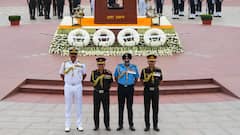Ladakh Border: Army Making Ponds For Troops To Get Drinking Water As Harsh Winter Approaches
In eastern Ladakh, where more than 50,000 Indian troops are stationed, temperatures can go down as much as minus 40 degrees Celsius in the winters.

With India locked in a 30-month standoff with China in eastern Ladakh, the Army is making a large number of ponds to ensure fresh drinking water for the troops even during the freezing winter season, ANI reported. In eastern Ladakh, where more than 50,000 Indian troops are stationed along with a large number of equipment to tackle possible Chinese aggression, temperatures go down as much as minus 40 degrees Celsius in the winters.
"We are making a big number of ponds to cater to the water requirements of the forces deployed there. In forward locations like the Daulat Beg Oldie (DBO), the troops used fresh water from ponds even in freezing winters this year," Indian Army's Engineer-in-Chief Lt Gen Harpal Singh told ANI.
Daulat Beg Oldie is one of the coldest locations in Ladakh and witnesses extreme frigid conditions. In such tough terrain, providing food or water to the troops has always been a massive challenge for the Army.
"The water at the surface level gets frozen in extreme winters but underneath, it remains in liquid form. Our troops used the water from these ponds to meet their requirements," he said.
The Corps of Engineers has taken a slew of steps to make the living conditions of troops better in eastern Ladakh.
The Army has so far built 22,000 additional habitats for the troops in eastern Ladakh. They have been built in a way that the structures can be lifted from one place to the other and relocated as per requirement in specific sectors, Lt Gen Harpal said.
A large number of habitats for the tanks, artillery guns and infantry combat vehicles have also been constructed to enable the armoured corps to operate them even in very cold conditions, ANI reported.
Meanwhile, the Indian Army will be constructing modular, 3D-printed next-generation bunkers to provide additional protection to the troops along the Line of Actual Control (LAC), PTI reported.
According to reports, the structure will be strong enough to withstand a direct hit from a T-90 tank from a mere 100 metres.
The main purpose of using 3D printing technology is to minimise the cost as well as time associated with constructing a conventional bunker. According to army officials, a single bunker can be printed in a matter of hours. These are likely to be operational from next year.






































